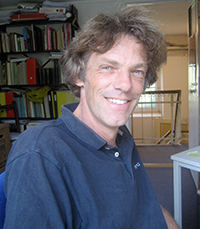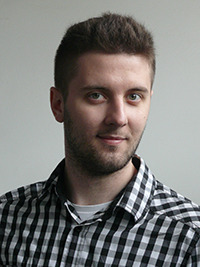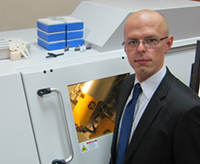 Błażej Błażejowski. Institute of Paleobiology, Polish Academy of Sciences, Twarda 51/55, 00-818 Warszawa, Poland. bblazej@twarda.pan.pl
Błażej Błażejowski. Institute of Paleobiology, Polish Academy of Sciences, Twarda 51/55, 00-818 Warszawa, Poland. bblazej@twarda.pan.pl
Research projects and expeditions
• 2013-2016 Leader of a grant from National Science Centre: Life in the Late Jurassic sea and sea shore: new Solnhofen-type taphonomic window in Sławno (central Poland)
• 2010 participation in Norwegian Polar Expedition
• 2006/2007 participation in Polska Ekspedycja Arktyczno-Antarktyczna, field work in Antarctic (King George Island), research topics: paleontology and sedimentology
• 2005 participation in Polska Ekspedycja Arktyczno-Antarktyczna, field work in Spitsbergen, research topics: paleontology and sedimentology
• 2004 participation in FMARS, field work in Canadian Arctic (Devon Island).
• 2002 co-organizer and participant of University of Warsaw students expedition, field work in Scotland and Western Hebrides
• 2002 co-organizer and participant of expedition to Spitsbergen
• 2000 co-organizer and participant of expedition to Mongolia
Research interests
• Methodology of reconstructing evolution from fossils and its paleontological record at the population level. Systematics, evolution, and biostratigraphy of Late Paleozoic foraminifera.
• Palaeoenvironment and taphonomy of a Late Jurassic (Late Tithonian) Lagerstätte from central Poland.
• End-Permian mass extinction. The Permian-Triassic crisis and multi-episode extinction around the P-T boundary.
• Isotopic composition of fossil marine vertebrate teeth.
• Climate Change in the Arctic and Antarctic.

 Paul Lambers. Universiteitsmuseum Utrecht, Lange Nieuwstraat 106, 3512 PN Utrecht, The Netherlands, p.h.lambers@uu.nl
Paul Lambers. Universiteitsmuseum Utrecht, Lange Nieuwstraat 106, 3512 PN Utrecht, The Netherlands, p.h.lambers@uu.nl
Curator of natural history at Universiteitsmuseum Utrecht

 Piotr Gieszcz. Independent Center for Advanced Research machinic.it, Stawki 4c/10, 00-193 Warszawa, Poland, pjogi@interia.eu
Piotr Gieszcz. Independent Center for Advanced Research machinic.it, Stawki 4c/10, 00-193 Warszawa, Poland, pjogi@interia.eu
M.Sc. in climatology and environmental protection at Warsaw University, after graduating worked as a technical manager at ILAC-certified laboratory of environmental chemistry, currently finishing his Ph.D. dissertation. Having a good training in geology and paleontology involved in research at the Owadów-Brzezinki site since first discoveries (2011). Analytical thinking, professional skills in isotope analysis and digital data processing are strengths that make substantial contribution to the team work in this and other projects. His field experience ranges from Mongolian and Chinese deserts to icy fields of Spitsbergen.
Interdisciplinary areas of scientific interest cover:
climatology, paleoecology and paleogeography,
isotope geochemistry,
nonlinear and spectral time-sequence data analysis and modeling,
genetic algorithms, cybernetics,
and various aspects of evolutionary biology.

 Daniel Tyborowski. Museum and Institute of Zoology, Polish Academy of Sciences,Wilcza 64, 00-679 Warszawa, Poland, d.tyborowski@student.uw.edu.pl
Daniel Tyborowski. Museum and Institute of Zoology, Polish Academy of Sciences,Wilcza 64, 00-679 Warszawa, Poland, d.tyborowski@student.uw.edu.pl
Daniel Tyborowski had his master degree in geology. In 2014 he started his Ph.D. at the Polish Academy of Science in vertebrate palaeontology, focusing on Late Jurassic marine reptiles and actinopterygian fishes. He's main research lines are osteology, taphonomy and biogeography.

 Marcin Binkowski. Department of Computer Science and Materials Science, University of Silesia, Katowice, Poland, marcin.binkowski@us.edu.pl
Marcin Binkowski. Department of Computer Science and Materials Science, University of Silesia, Katowice, Poland, marcin.binkowski@us.edu.pl
Lecturer at the Institute of Computer Science (University of Silesia, Katowice, Poland). He got a PhD in Biomedical Engineering (2007, Institute of Biocybernetics and Biomedical Engineering, Polish Academy of Science, Warsaw, Poland). He conduct part of the PhD project at the University of Basel (2005, Switzerland) and at the University of Nijmegen (2006, Netherlands).
He got post-doctoral fellowship (2007, Foundation for Polish Science, Poland) for visit at the Institute of Orthopaedics & Musculoskeletal, (2007-2008, University College London, United Kingdom). After coming back to Poland he created the X-ray Microtomography Lab. Currently he is responsible for research in assessment of bone microstructure, X-ray Microtomography (XMT) images analysis, 3D Printing of biomedical tools, and daily managing of 12 PhD ongoing projects. He has been selected as a one from first 40 scientists for entrepreneur fellowship financed from governmental program Top500 Innovators (October-December, 2011, Stanford University, USA).
He created the n-LAB (2012, first university spin-out - small enterprises) company based on infrastructure of the XMT Lab, which provides the services in Non-Destructive Tests and 3D printing for universities, hospitals and industry. Since 2012 he was involved in number of project related to printing 3D models for surgical planning including reconstructive maxillo-facial surgery and face transplantation.


